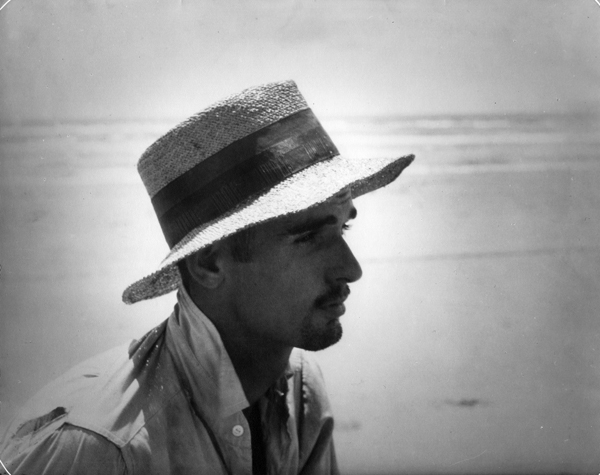Theodore Fonville Winans
With his black-and-white photographs, Theodore Fonville Winans documented the people, landscape, and culture of mid-twentieth century Louisiana.

Courtesy of State Library of Louisiana
Photographer Fonville Winans on the Louisiana coast in 1934. Unidentified
With his black-and-white photographs, Theodore Fonville Winans documented the people, landscape, and culture of mid-twentieth century Louisiana. During his lifetime, Winans earned recognition as a commercial photographer who often photographed Louisiana politicians, including many of the state governors. Today, however, Winans is best known for his images of southern Louisiana’s wetlands and the Cajuns who lived there. More than one hundred of his images were published in the 1995 book, Fonville Winans’ Louisiana: Politics, People, and Places.
Born August 22, 1911, in Mexico, Missouri, Winans was the son of Lawrence Winans and Ruth Fonville. Lawrence Winans’ work as a civil engineer led the family to settle in Ft. Worth, Texas, where Fonville spent much of this boyhood. As a senior in high school he bought his first camera and only a few days later won a photography contest. When his father was hired to help construct a bridge in Morgan City, Louisiana, Fonville and his camera went along with him. Quickly becoming fascinated with his new environs, Fonville found a small boat and began traveling through the swamplands of south central Louisiana, photographing it with 16mm and Kodak cameras. “It was absolutely fascinating to me,” he wrote of his journeys through the bayous and swamps. “It was like being in the darkest Africa, alligators, palmettos and Spanish moss. I tell you, it really grabbed a hold of me. To me, it was pure adventure.” Winans continued to explore and photograph southern Louisiana throughout the 1930s and 1940s. One of his favorite destinations was Grand Isle, where he made several of his best-known images. Winans never intended his work in southern Louisiana to be commercial; his images were taken for personal rather than professional use.
Ready to give up his “adventuring” for a more stable career, Winans enrolled in Louisiana State University in 1934. While majoring in journalism, he photographed activities at the university, some of which were published in the school yearbook. In 1938 Winans took a job with the State of Louisiana as a photographer in charge of documenting industry. His work provides a comprehensive survey of the commercial life of the state, including oil fields, paper mills, the sugarcane industry, moss companies, and even a frog-canning business. He also photographed rice harvests, shrimping, oystering, fishing, and farming. One of his best-known pictures was made in 1939 in an underground salt mine at Avery Island.
In the mid-1930s Winans made his first political portraits, initiating what would become another lifelong fascination. Over the years he photographed many of the most important political figures in the state, including governors Huey Long, Earl Long, Edward Edwards, Richard Leche, Sam Jones, and Jimmie Davis. In 1940 he opened his own commercial photography business in Baton Rouge, where he lived and worked until his death on September 13, 1992.
Although much of his work was relatively unknown for many years, his photographs have appeared in several publications, including Harnett T. Kane’s “Bayous of Louisiana” (1943), William Faulkner’s “Rushton’s The Cajuns” (1979), and Myron Tassin’s “Nous Sommes Acadiens/We Are Acadians” (1976). In 1990, the Foundation for Historical Louisiana recognized Winans’ contributions to the historical record by awarding him its Preservation Award. In 1999, his Baton Rouge studio was listed on the National Register of Historic Places.
